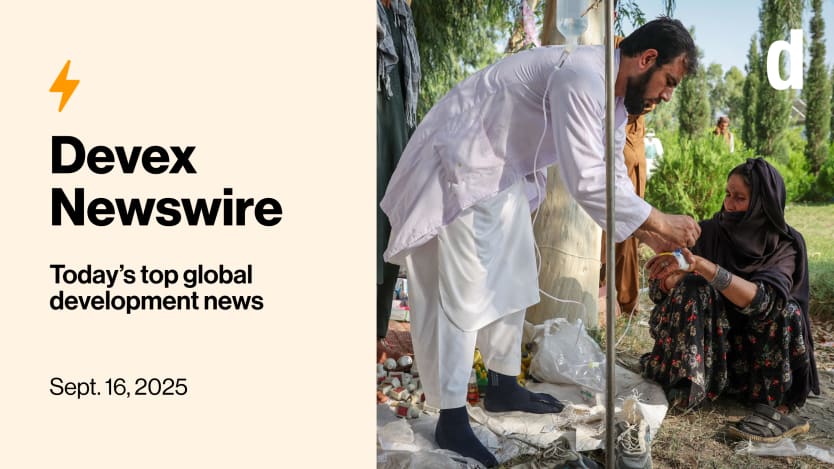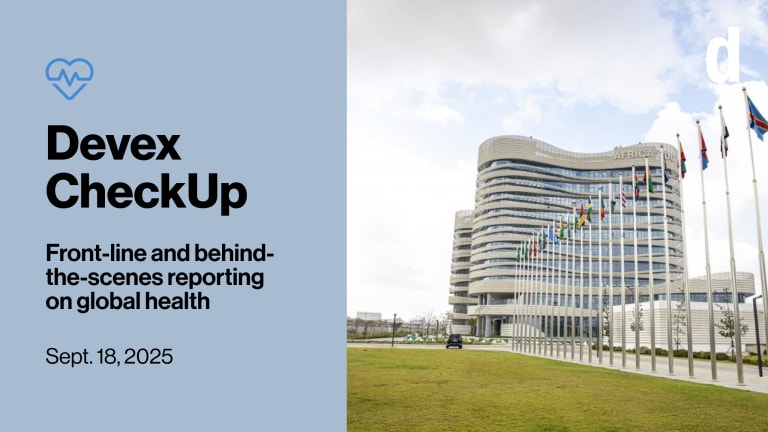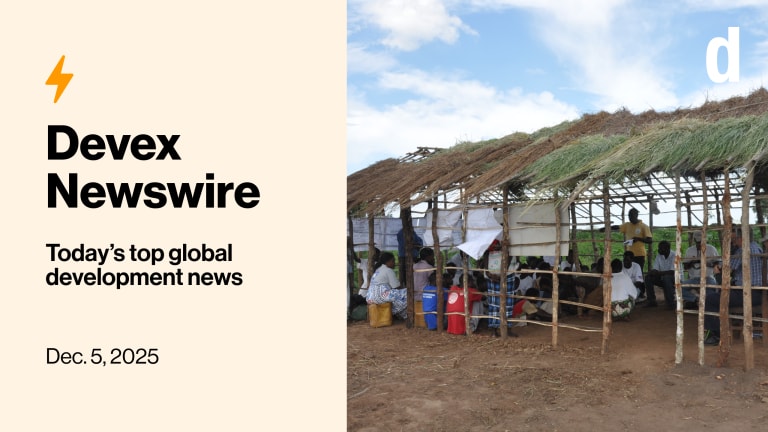Presented by World Health Summit

Afghanistan briefly made it back in the headlines two weeks ago when a magnitude 6 earthquake struck, killing thousands and displacing many more. But the story is notable not only for what happened in the aftermath, but also for what didn’t happen beforehand that could’ve lessened the fallout.
Also in today’s edition: When disasters like the Afghanistan earthquake strike, who else can communities call on for help?
+ Happening today at 9 a.m. ET: We’re hosting a look-ahead to UNGA80. Join Colum Lynch, our U.N. correspondent, along with Richard Gowan of the International Crisis Group and Elizabeth Campbell of ODI Global, for a discussion on how this year’s UNGA could shape the global agenda. Register here. If you can’t attend live, we’ll send you a recording.
An ounce of prevention
America’s ability to respond to humanitarian disasters overseas has arguably been shattered in the wake of the dissolution of USAID. But the agency also played a significant role in building up resilience that helped cushion the blow of disasters in vulnerable communities such as the eastern provinces of Afghanistan that are still reeling from a powerful earthquake on Aug. 31.
For decades, USAID didn’t just focus on immediate emergencies; it expended tremendous effort on prevention. From funding rural health clinics and food security programs to supporting logistics operations that could reach remote mountain villages, USAID helped countries prepare for inevitable shocks.
Then all of that abruptly stopped — and the results are becoming visible when those inevitable shocks hit.
Since U.S. funding cuts earlier this year, more than 420 health facilities across Afghanistan have closed, including 80 in the eastern region where the earthquake struck, my colleague Jesse Chase-Lubitz writes.
Meanwhile, the U.N.’s humanitarian air service, once bolstered by international donors, was forced to cut back its helicopter fleet earlier this year, making it nearly impossible to reach stranded Afghans. Even mine clearance, another sector USAID had long invested in, has slowed, leaving earthquake-displaced families at risk of stepping on newly exposed ordnance.
“When funding runs dry, or there are significant cuts like the ones that we’ve seen, the first thing to go is prevention,” Kate Carey, the humanitarian affairs officer at the United Nations Office for the Coordination of Humanitarian Affairs, tells Jesse. “The preventative measures that we would like to implement in order to prevent a situation like this got cut. We are forced to triage — to save lives today, while knowing the lack of preparedness will cost lives tomorrow.”
Read: Aftermath of Afghan quake shows fallout of USAID withdrawal
Seeing red
With the U.S. essentially MIA for overseas disasters, the Red Cross is calling on philanthropies to wade into the fragile humanitarian contexts where crisis is common.
“We need philanthropy to step in with us in these difficult places, because the states have a dwindling capacity to respond to it,” Balthasar Staehelin, the head of the International Committee of the Red Cross’ regional delegation for East Asia, said at the recent AVPN conference in Hong Kong, where different funders came together. However, “the question is, will you go also to the hard places … or will you go to the more easy places?” he asked philanthropists in the room.
Meanwhile, some of those philanthropists offered their own insights on what works on the front lines — starting with something as simple as listening.
“I often joke with my children [that] there’s a difference between hearing and listening. To hear is just to hear my words, but to listen is to hear and think about what I’m trying to say and then potentially, hopefully, take action on those,” said Shivani Garg Patel, chief strategy officer at the Skoll Foundation, which launched an emergency fund and a pivot fund in response to the U.S. funding cuts.
Both funds included flexible funding. But Patel said that by listening, they learned funding is not always the only thing organizations need.
“Over 80% said, ‘We need help on strategic planning. We need help on financial planning. We need connections to places that are going to help us access those capabilities and relationships into these new networks,’” she said.
For Staehelin, it all adds to the power of prevention.
“The most important impact is what does not happen,” he said. “It’s the hospital that is not bombed; it’s the civilians that are not displaced; it’s the prisoners that are not tortured; it’s the women that are not raped.”
Read: Red Cross official calls on philanthropy to assist in crisis zones
+ How can philanthropies fund development better? We recently hosted a panel of philanthropy funders and advisers to discuss this in a briefing exclusively for Devex Pro members.
Not yet gone Pro? Start your 15-day free trial today and watch the recording as well as all our other events and content exploring how philanthropy and the private sector have been responding to the decline in traditional aid.
The business of crisis
From armed conflict to climate-fueled displacement and disasters, the response to all-encompassing humanitarian emergencies needs to be all-encompassing as well. That means just not traditional donors and philanthropies, but the private sector.
“The future of humanitarian response depends on building a broader coalition of players — drawing not just on public institutions and NGOs, but also on the capacity, reach, and problem-solving capabilities of the private sector,” argues John W.H. Denton AO, the secretary-general of the International Chamber of Commerce, in a Devex opinion piece.
He cites Ukraine as an example of this synergy. “Flexport, a global logistics and technology firm, responded within two weeks of the Russian invasion of Ukraine in 2022 by building supply chains to deliver aid across Ukraine and neighboring countries,” he writes. Since then, its social impact arm, Flexport.org, has funded and managed the delivery of more than 23 million pounds (around 10.4 million kilograms) of essential goods, including medical supplies and food aid, “coordinating with humanitarian agencies to ensure supplies arrive where and when they’re needed.”
“A million dollars in logistics or digital infrastructure, deployed through a company’s expertise and networks, can often do more for people in need than a million-dollar check,” he adds.
Opinion: Why business should co-lead in crisis response
The humble pharmacy
When we think of health care, we often think big and high tech, whether it’s in Boston or Burkina Faso. But we also often forget about that drugstore around the corner, which can also serve as a critical health care hub.
Onuh Edoka, a pharmacist and co-founder of Fedox Pharmacy, writes in a Devex opinion piece that “the next practical breakthrough may be far humbler and closer to home. In Africa, it could start in a pharmacy on a busy street in Abuja, Accra, or Nairobi.”
“The continent faces health care deserts. Clinics are hours away, hospitals are overstretched, and treatable illnesses often become emergencies,” he adds. “Yet one reliable piece of infrastructure frequently exists even in remote settlements: the local pharmacy. Open, trusted, and embedded in daily life, community pharmacies could become the next frontier of primary care.”
Edoka points out that across Africa, pharmacies are often the first point of care. “With modest investments and smarter regulations, these familiar shops could evolve into decentralized health hubs offering teleconsultations, basic diagnostics, chronic care follow-ups, vaccinations, and secure medicine dispensing. In effect, they could provide primary care where people live, work, and shop.”
Opinion: African pharmacies have potential as the next frontier in primary care
Will there be cake?
The United Nations is marking its 80th year at this month’s U.N. General Assembly, but there’s another anniversary being commemorated on the sidelines of UNGA: the 20th anniversary of the Clinton Global Initiative.
“Since 2005, more than 500 million people in more than 180 countries have had their lives improved by more than 4,000 Commitments to Action launched through CGI,” according to a press release.
So who’s coming to toast the occasion? Here’s a sampling:
Cindy McCain, executive director, World Food Programme; Matt Damon, co-founder, Water.org and WaterEquity; Peter Sands, executive director, The Global Fund to Fight AIDS, Tuberculosis and Malaria; Hamdi Ulukaya, CEO and founder, Chobani; Ryan Gellert, CEO, Patagonia; Sania Nishtar, CEO, Gavi, the Vaccine Alliance; and Tom Fletcher, U.N. undersecretary-general for humanitarian affairs and emergency relief coordinator.
In other news
Soaring accommodation costs in the Brazilian host city of Belém have prompted even the United Nations to scale back its own delegation to COP30. [Reuters]
Nearly 3,000 people have been killed while seeking aid in Gaza from January 2024 to Sept. 9, 2025. [The New Humanitarian]
The Earth’s ozone layer is healing, and the Antarctic hole could fully disappear within the next few decades, according to the World Meteorological Organization. [France 24]
Sign up to Newswire for an inside look at the biggest stories in global development.








